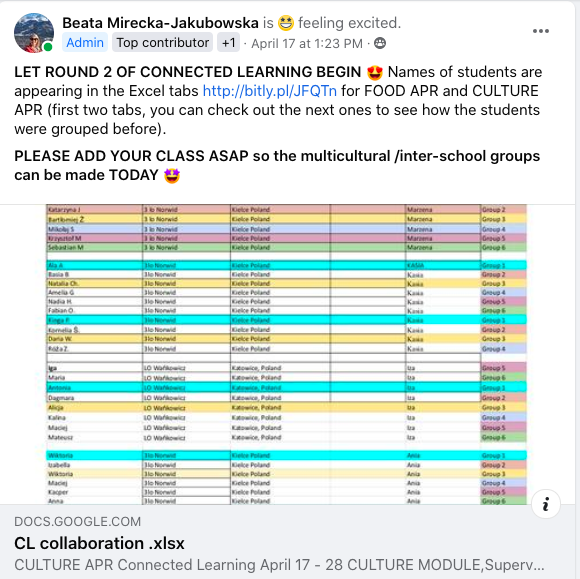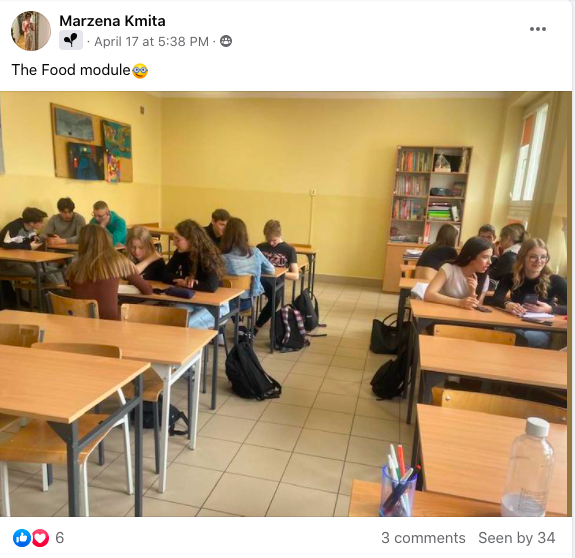|
Czy można zwiększyć skuteczność przyswajania treści realizowanych w ramach podstawy programowej, wykorzystując możliwości, jakie daje korzystanie z platformy cyfrowej? Czy możliwy jest wzrost motywacji wewnętrznej uczniów do nauki oraz rozwijanie w jej trakcie nie tylko kompetencji językowej, ale również cyfrowej i kompetencji przekrojowych?
Odpowiedź brzmi: tak! To wszystko okazuje się możliwe dzięki realizacji międzynarodowego projektu Connected Learning. Jaki jest cel projektu? Odpowiedź na to pytanie oraz wiele innych opisała Katarzyna Pelc w swoim artykule - do pobrania poniżej. Oto fragmenty artykułu: Celem projektu jest "inspirowanie nauczycieli do wdrażania innowacyjnych rozwiązań sprzyjających rozwojowi kompetencji uczniów. Projekt odwołuje się do teorii poznawczej, a w szczególności konstruktywizmu poznawczego, w którym ważna jest „aktywna postawa ucznia, jego dociekliwość i wewnętrzna motywacja, umiejętność rozwiązywania problemów. Efektem spotkań edukacyjnych jest przede wszystkim rozumienie i nadawanie znaczeń, nie tylko wykonywanie zadania (...) i powinny one uwzględniać naturalny i zarazem społeczny charakter (uczenia się)” (Skałbania 2020: 125 za Bałachowicz 2009: 126). [...] Projekt "oferuje holistyczne podejście do edukacji, które wykorzystuje możliwości technologii, jednocześnie wspierając znaczące, społecznie osadzone i oparte na zainteresowaniach uczniów doświadczenia edukacyjne. Ze względu na swoją darmową formę stanowi doskonały sposób na uzupełnienie procesu nauczania i uczenia się, wspierając jego skuteczność poprzez wykorzystanie wyżej opisanych atutów edukacji pozaformalnej." ARTYKUŁ JEST DO POBRANIA I PRZECZYTANIA W CAŁOSCI link ********************************************************************************* Can the effectiveness of assimilating content implemented within the curriculum be increased by utilizing the possibilities offered by digital platforms? Is it possible to enhance students' intrinsic motivation for learning and develop not only language competence but also digital and cross-cutting competencies during the learning process? The answer is: yes! All this turns out to be possible thanks to the implementation of the international Connected Learning project. What is the aim of the project? The answer to this question and many others has been provided by Katarzyna Pelc in her article - available for download below. Here are excerpts from the article: The aim of the project is to "inspire teachers to implement innovative solutions conducive to the development of students' competencies. The project refers to cognitive theory, particularly cognitive constructivism, in which the 'active attitude of the student, their curiosity and internal motivation, problem-solving skills are important. The result of educational meetings is primarily understanding and attributing meaning, not just performing tasks (...) and they should take into account the natural and social character (of learning)" (Skałbania 2020: 125 according to Bałachowicz 2009: 126). [...] The project "offers a holistic approach to education, which utilizes the possibilities of technology while supporting significant, socially embedded, and interest-based educational experiences for students. Due to its free form, it is an excellent way to complement the teaching and learning process, enhancing its effectiveness through the use of the above-described advantages of non-formal education." HERE IS THE ENTIRE ARTICLE TO DOWNLOAD AND READ (in Polish)
0 Comments
On April 17th 2023 another round of Connected Learning began, with FOUR classes collaborating together on each of the units available for use at this moment, the FOOD and the CULTURE unit.
There have been upgrades, improvements and tweaks applied to the two units, following collection of feedback from all users after Round One completed in February 2022. The feedback underwent careful analysis during the Project Meeting at Katowice in March 2023. You can read all about this Project Meeting on our website, Actions & Events --> Live Meetings in Poland. AS the photographs below testify, students are super engaged in the classes, working together and discussing the solutions for the provided tasks. On February 13, 2023, the two-week process of student collaboration and learning together commenced on the first two thematic modules, FOOD and CULTURE. 39 students from 6 schools and 3 countries - Poland, Iceland and Greece - began their adventure with CULTURE. 79 students from 8 schools and 4 countries - Poland, Iceland, Greece and Indonesia - started sharing their FOOD stories. The 118 students are collaborating on various tasks, wither face-to-face with their peers in their respective classrooms, or sharing information online with their intercultural teams. Have a look at the slide show of photos below to gain a better understanding of how this collaboration looks. Join us for the next edition of collaborative learning, with these two or the new thematic modules that will be available soon! What to do before the collaboration starts?Here's what Kasia Pelc did - inspirational!
"I introduced this new topic of work in the blended learning project and partially new working methods to my students as follows: 1. I asked about the advantages of project work that my students know...although not in an international dimension... 2. I asked if they had heard of critical thinking and what they thought it was. 3. I asked what other important competencies are currently needed by people in interesting jobs. I referenced them to the job postings. 4. The students easily exchanged the other 4 Cs i.e. creativity, communication, cooperation and even emotional intelligence 5. We discussed the rules of online communication, in an international environment, with an emphasis on cultural differences and possible different reception of various content, e.g. jokes, emoticons, etc... I showed where they can find ready-made phrases. 6. I also showed them what online tools will be used. What a nice feeling to know more than they do... e.g. they don't know FLiP 7. They have now started working on the first task They are sitting, motivated and involved. I am very happy to see how the student is at the center of the learning process and how it triggers the learning process. There are no bored looks... there is action. Priceless!!!" Here you will find answers to Frequently Asked QuestionsWhat is the goal of Connected Learning? The authors of Connected Learning Modules promote thoughtful education that engages technology to provide opportunities for collaboration and practice of higher order thinking skills in English class. Our example units (Modules) structure learning of English in a captivating way focused on 21st century skills training. We hope that our Modules will inspire other teachers to add Connected Learning to their repertoire of teaching methods! Is Connected Learning a paid service? No, it is not. All modules are available for free. Teachers can use them whenever they want and as many times as they want. Free thematic lesson plans in modules? How is it possible? Our project benefits from co-financing of approx. EUR 186,000 received from Iceland, Liechtenstein and Norway as part of the EEA Grants. The project is also partially financed from the Polish state budget. The aim of the project is to increase teachers' competences, modernize pedagogy thanks to the implemented innovations, and promote wider use of the concept of learning through international cooperation of students. For which learners are the thematic lesson modules designed? Our modules are designed for teenage learners (approx. high school age) with English level spreading from B1 to C1 on CEFR scale (see CEFR comparison with TOEFL or IELTS scores). This is only our suggestion – you can try the modules with learners of all ages and levels if you find the lessons purposeful for your curriculum. How do I get started with these thematic lesson modules?
Where do I find another class to collaborate with? It’s up to you. You can suggest starting a Connected Learning adventure with a teacher(s) and/or school(s) that you already collaborate with on other projects, or just your friendly English teachers. Alternatively, you can sign up for the CONNECTED LEARNING FACEBOOK GROUP where you can post your interest in the modules and find a partner teacher(s) whose students will collaborate with yours at a mutually agreed time of the school year. Finally, you can email us at [email protected] so we can try to connect you with the schools from our educational projects. Do I need to have a school from abroad to collaborate with? No, that's not necessary. Although the thematic module activities are great fun for intercultural exchange if you collaborate with a foreign group, you can also work through the modules with a school from your own country or city, or even just on your own, with your own students. Collaboration greatly enriches the learning, but all modules are designed for both individual and group work. Can I modify the lessons? Of course! Remember to double check with your partner teacher(s) and group(s), so that you all agree on the changes and they don’t interfere with your co-learning. When should I work through the modules? Absolutely any time you want. Each module is designed for approximately 1-2 weeks of engagement. Decide with your partner teacher(s) and group(s) on a convenient time frame if you will work collaboratively, or rely on your personal calendar if you work individually. What should I do when I complete the work on one thematic module? Celebrate your learning outcomes! If you want to share your feedback, email us at [email protected] - we’ll be delighted to hear all about it! Remember to send us links to your published learning outcomes, too! Then, if you liked our thematic collaborative module, go ahead and collaborate on another one. There are eight, and each is filled with different activities, so your students will remain engaged throughout all of the topics. What is the Strengths-finder Analyzer and where is it located? The Strengths-finder Analyzer questionnaire aims to help you analyse your strengths and weaknesses to prepare for online/hybrid collaboration and achieve better educational results. The survey mainly focuses on your readiness and personal attitude to become a teacher of the future! We hope our suggestions and experience will help you smoothly navigate between online and in-class lessons. The Strengths-finder Analyzer is divided into four parts:
What information do I get in the Connected Learning webinar and where is it located? If you dream of teaching a class of highly-motivated and responsible teenagers, we encourage you to watch our professional training webinar to:
How do I sign up for the Connected Learning Facebook group? You'll need a Facebook profile to sign up for the CONNECTED LEARNING FACEBOOK GROUP where you can post your interest in the modules and find a partner teacher(s) whose students will collaborate with yours at a mutually agreed time of the school year. Alternatively, you can fill out THIS FORM, so we can try to connect you with the schools from our educational projects. |





